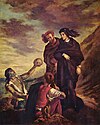Hamlet is a tragedy by William Shakespeare, probably written between 1599 and 1601. Set in Denmark, the play tells how Prince Hamlet exacts revenge on his uncle for murdering the previous king, Hamlet's father. Hamlet's uncle has since stolen the throne and taken Hamlet's mother, the dead king's widow, as his wife. The play vividly charts the course of real and feigned madness—from overwhelming grief to seething rage—and explores themes of treachery, incest, and moral corruption. Despite much literary detective work, the exact year of writing remains in dispute. Three different early versions of the play survived, which are known as the First Quarto, the Second Quarto, and the First Folio. Each has lines, and even scenes, that are missing from the others. Shakespeare probably based Hamlet on an Indo-European legend—preserved by a 13th-century chronicler, and retold by a 16th-century scholar—and a lost Elizabethan play known today as the Ur-Hamlet. The play's dramatic structure and Shakespeare's depth of characterisation mean that Hamlet can be analysed and interpreted—and argued about—from many perspectives. Hamlet is by far Shakespeare's longest play, and among the most powerful and influential tragedies in the English language. The title role was almost certainly created for Richard Burbage, the leading tragedian of Shakespeare's time; in the four hundred years since, it has been played by the greatest actors, and sometimes actresses, of each successive age.
